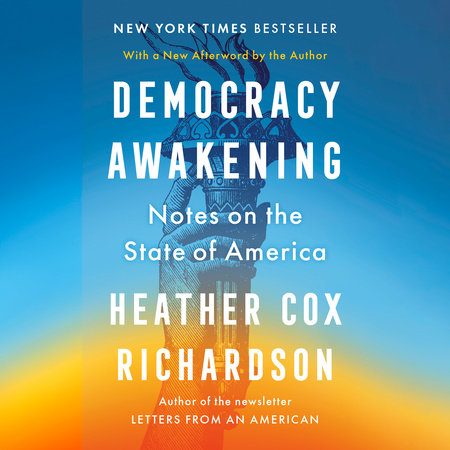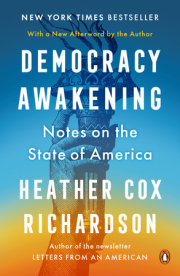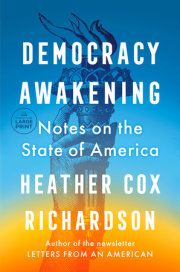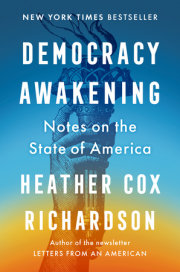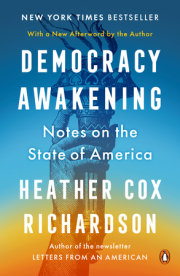Chapter 1
American Conservatism
Today's crisis began in the 1930s, when Republicans who detested the business regulation in President Franklin Delano Roosevelt's New Deal began to flirt with the idea of making a formal alliance with two wings of the Democratic Party to stand against it. They turned to southern Democrats, who hated that New Deal programs were not overtly segregationist, and westerners who disliked the idea of the federal government protecting land and water. Those contemplating the alliance used the word conservative to signify their opposition to the New Deal. They insisted that a government that answered to the needs of ordinary Americans was a dangerous, radical experiment.
This was not an accurate description of conservatism: it was a political position. In the 1920s, Republicans had taken control of both Congress and the White House from Progressive Era Democrats. They turned the government over to businessmen, believing that they would reinvest their money as only they knew best, providing jobs for workers and exciting products for a new middle class. At first, as the nation's new glossy magazines advertised refrigerators and radios, stockings and speedboats, those policies seemed miraculous.
But then the Great Crash of 1929 and the Great Depression that followed it revealed how poorly distributed the nation's paper prosperity had been. FDR, then the Democratic governor of New York, warned that the Republican system worked only for those at the top. "Democracy is not safe if the people tolerate the growth of private power to a point where it becomes stronger than their democratic state itself," he later explained. "That, in its essence, is Fascism-ownership of Government by an individual, by a group, or by any other controlling private power." He told the American people they deserved a "New Deal."
Desperate to break out of the Depression, Americans embraced FDR's promise to use the federal government to protect ordinary Americans. In 1932 they elected him president and put Democrats in charge of Congress. In place of businessmen, Democrats brought into the government new voices like law professors and economic advisors-a so-called Brain Trust.
Crucially, FDR also turned to Frances Perkins, who brought to the table the idea that the federal government should protect workers and women and children. A well-educated social worker, Perkins was a descendant of a colonial family and had spent significant time in a small town in Maine. In 1911, she had witnessed New York City's horrific Triangle Shirtwaist Factory fire, in which 146 workers, mostly young women, leaped to their death from a burning building after their bosses had locked the doors to keep them from sneaking breaks on the fire escapes. The catastrophe inspired Perkins to bring the idea of old-fashioned community responsibility to the government, addressing the working conditions in rapidly growing cities, with their immigrant populations and their unregulated industries.
Recognizing the growing power of women in the Democratic coalition and eager to understand the needs of marginalized Americans, FDR named Perkins to his cabinet as secretary of labor. The first woman in a presidential cabinet, she served from 1933 to 1945, making her the longest serving labor secretary in U.S. history.
To get rid of the financial free-for-all that had sparked the Great Crash and the Great Depression, Congress regulated the stock market and limited the ability of bankers to use depositors' money to speculate in stocks. It also set maximum weekly hours and minimum wages for workers-forty-four hours and twenty-five cents an hour-and prohibited child labor. It guaranteed workers the right to join unions. It provided jobs for the unemployed, and it raised tax rates on the wealthy.
Congress also provided jobs programs for workers thrown into the streets by the Depression and created a basic social safety net-the centerpiece of which was Perkins's Social Security Act-for women and children and workers out of a job from unemployment or retirement. Finally, the government invested heavily in infrastructure, bringing to ordinary Americans new opportunities previously available only to the wealthy.
From the first, FDR's New Deal included-imperfectly, but included-Black Americans and women.
Racist southern Democrats hated the new system. So did a rump group of Republicans, despite the fact that their own utter failure to manage the economy had left people living in packing boxes and eating out of garbage cans. In 1937, after Roosevelt's triumphant reelection, members of these two groups set out to organize against the New Deal. They agreed that the growing power of the federal government threatened what they called "traditional values": individual hard work, private property, a balanced federal budget, and local control of politics.
In early December 1937, a coalition of anti-New Deal lawmakers of both parties wrote a formal declaration of their principles and quietly circulated it to likely sympathizers. On December 15, 1937, their Conservative Manifesto leaked to the press. Called "An Address to the People of the United States," it rejected the idea of public spending and called private investment the bedrock of the economic health of the nation.
To free up capital, the manifesto demanded tax cuts and cuts to social welfare spending. It called for an end to government support for labor, which, it claimed, "injures all." It called for "states' rights, home rule and local self-government," by which it meant that federal laws must not disrupt southern states' racial codes. It called for an end to public support for able-bodied individuals with a "view to encourage individual self-reliance," trusting "kinship and benevolence" to provide a social safety net. "We propose," the manifesto read, "to preserve and rely upon the American system of private enterprise and initiative. . . ."
The declaration received little congressional support. Republicans preferred to attack FDR without tying themselves to Democrats, and Democrats criticized those around FDR rather than be seen publicly undermining their president. But the manifesto caught the attention of whites-only citizens' organizations and chambers of commerce, which endorsed it, and business and manufacturing organizations republished and circulated almost two million copies. Anti-New Deal newspapers continued to reprint it. The Conservative Manifesto was a blueprint for those who stood against FDR's New Deal, and it's this declaration of values that makes today's radicals claim to be "conservatives."
But this is not the historical meaning of conservatism in America.
The idea of a "conservative" stance in politics emerged during the French Revolution, when Anglo-Irish statesman Edmund Burke recoiled from what was happening on the other side of the English Channel. As revolutionaries in France abolished the traditional hierarchies of government and the church, Burke took a stand against radical change driven by people trying to make the government enforce a specific ideology. Ideologically driven government was radical and dangerous, he thought, because the ideology quickly became more important than the reality of the way society-and people-actually worked.
In 1790, Burke argued that the role of government was not to impose a worldview, but rather to promote stability, and that lawmakers could achieve that stability most effectively by supporting traditional structures: social hierarchies, the church, property, the family. "Conservative" meant, literally, conserving what was already there, without reference to an ideology. Those in charge of government should make changes slowly, according to facts on the ground, in order to keep the country stable. This idea also meant that government could be a positive force in society, rather than a negative one.
That "conservative" political identity did not translate particularly well to America, where, because leaders were still creating the new government out of whole cloth, there was nothing long-standing to conserve. Until the 1840s, the word rarely appeared in the political realm, and when it did, it referred to someone who rejected the "radical" ideas of abolitionists, who wanted to end human enslavement, or of women's rights activists, who wanted to give women the vote.
The word conservative began to take on specific political meaning in the U.S. when antislavery northerners refused to honor the Fugitive Slave Act that was part of the Compromise of 1850. That law required federal officials, including those in free states, to return to the South anyone a white enslaver claimed was his property. Black Americans could not testify in their own defense, and anyone helping a "runaway" could be imprisoned for six months and fined one thousand dollars, which was about three years' income.
Enslavers and their Democratic colleagues began to call those speaking out against the Fugitive Slave Act "radicals" because they rejected a law. Charges of "radicalism" spread more widely four years later when northerners of all parties organized against the 1854 Kansas-Nebraska Act, under which Congress allowed the spread of slavery into lands that had for more than thirty years been set aside for free labor.
In December 1855, Democratic president Franklin Pierce used his annual message to Congress to accuse Americans who opposed the spread of slavery of trying to overturn American traditions. He described the United States as a white man's republic and claimed that the Founders had believed in a hierarchy of races, in which "free white men" ruled over "the subject races . . . Indian and African."
The editor of the Chicago Tribune, lawyer and staunch abolitionist Joseph Medill, was outraged. He accused Pierce and his Democratic supporters, not the antislavery men, of attacking American laws. "There are perversions of historical facts, and false statements, in Gen[eral] Pierce's Message, which cannot fail to arrest the attention and shock the feelings of the most conservative among us," he wrote.
Medill had claimed the word conservative for the cause of equality.
The editor called out as "False all through!" Pierce's declaration that the Founders had established "a Federal Republic of the free white men of the Colonies." In fact, he wrote, the Founders had enshrined the nation's principles in the Declaration of Independence. Where in that document was the discussion of "free white men," the editor asked. In it, he continued, "Is there an intimation about 'the subject races,' whether Indian or African? . . . Their 'one guiding thought,' as they themselves proclaimed it, was the inalienable right of ALL men to Freedom, as a principle."
As the Republican Party took shape over the next few years, its members worked to undercut charges that they were wild-eyed radicals, "Black Republicans," and "N****r worshippers." They embraced the idea that opposing slavery was a conservative stance. When Democratic Illinois senator Stephen A. Douglas tried to portray his political opponent Abraham Lincoln as a "radical abolitionist" in 1858, Lincoln hammered home the idea that it was Douglas and his supporters, not the Republicans, who were radicals. Lincoln claimed to be fighting against slavery "on 'original principles'-fighting . . . in the Jeffersonian, Washingtonian, and Madisonian fashion."
Lincoln did not use the word conservative in the Lincoln-Douglas debates, but on February 27, 1860, at New York City's Cooper Union, he claimed the mantle of conservatism for the Republicans. Much as Pierce had done in his controversial 1855 message, Lincoln retold the history of America. In his version, though, that history was one in which the Founders opposed slavery, and the new Republican Party stood on their side.
"You say you are conservative-eminently conservative-while we are revolutionary, destructive, or something of the sort," he said, addressing Democrats. "What is conservatism? Is it not adherence to the old and tried, against the new and untried? We stick to, contend for, the identical old policy on the point in controversy which was adopted by 'our fathers who framed the Government under which we live'; while you with one accord . . . spit upon that old policy, and insist upon substituting something new. . . . Not one of all your various plans can show a precedent or an advocate in the century within which our Government originated."
When voters elected Lincoln president later that year, his centering of the Declaration of Independence led the Republican Party to create a new, active government that guaranteed poorer men would have access to resources that the wealthy had previously monopolized. They put men onto homesteads, created public universities, chartered a transcontinental railroad, invented national taxation (including the income tax), and, of course, ended Black enslavement in America except as punishment for crime. As Lincoln wrote, "The legitimate object of government, is to do for a community of people, whatever they need to have done, but can not do, at all, or can not, so well do, for themselves-in their separate, and individual capacities."
By 1865 the party of Lincoln had put into practice their conservative position that the nation must, at long last, embrace the principles embodied in the Declaration of Independence: that all men are created equal and must have equal access to resources to enable them to work hard and rise. That was the same position underpinning the New Deal, and those taking a stand against its business regulation and racial advances in the 1930s were not true American conservatives; they were the same dangerous radicals Lincoln and the Republicans of his era warned against.
Chapter 2
The Liberal Consensus
The New Deal did not immediately end the Depression or level the nation's racial playing field, but it won the loyalty of Americans who blamed the rich for having manipulated the economy until the Great Crash revealed its hollow core. Still, Americans were wary enough of what Republicans called "socialism" to make FDR's program precarious. In 1937, worried about deficits and attacks from the right, FDR began to cut federal spending, ultimately by about 17 percent. Unemployment shot back up, and the stock market, which had begun to recover, fell again. It was not at all clear that the New Deal system would survive.
Then, on the sunny Sunday morning of December 7, 1941, in a surprise attack, 353 Japanese aircraft bombed the U.S. naval base at Pearl Harbor, in Honolulu, Hawaii, killing or wounding more than 3,500 Americans and destroying U.S. aircraft and ships. Two hours later, Japan declared war on the United States. The next day, the U.S. declared war on Japan, and on December 11, 1941, four days after the bombing of Pearl Harbor, both Italy and Germany declared war on America. "The powers of the Pact of Steel, fascist Italy and national-socialist Germany, ever more closely united, stand beside heroic Japan against the United States of America," Italian leader Benito Mussolini said. "We will be victorious!"
The steel pact was the vanguard of a new political ideology. Mussolini had been a socialist as a young man and had grown frustrated with how hard it was to organize people. No matter what socialists tried, they seemed unable to convince their neighbors that they must rise up and take over the country's means of production. The efficiency of World War I inspired Mussolini to give up on socialism and develop a new political theory.
He rejected the equality that defined democracy and came to believe that some men were better than others. Those few must lead, taking a nation forward by directing the actions of the rest. They must organize the people as they had during wartime, ruthlessly suppressing all opposition and directing the economy so that business and politicians worked together. Logically, that select group of leaders would elevate a single man, who would become an all-powerful dictator. To turn their followers into an efficient machine, they demonized opponents into an "other" that their followers could hate.
Copyright © 2024 by Heather Cox Richardson. All rights reserved. No part of this excerpt may be reproduced or reprinted without permission in writing from the publisher.

